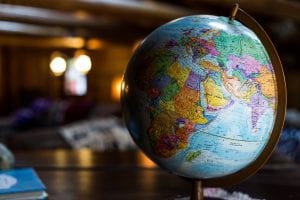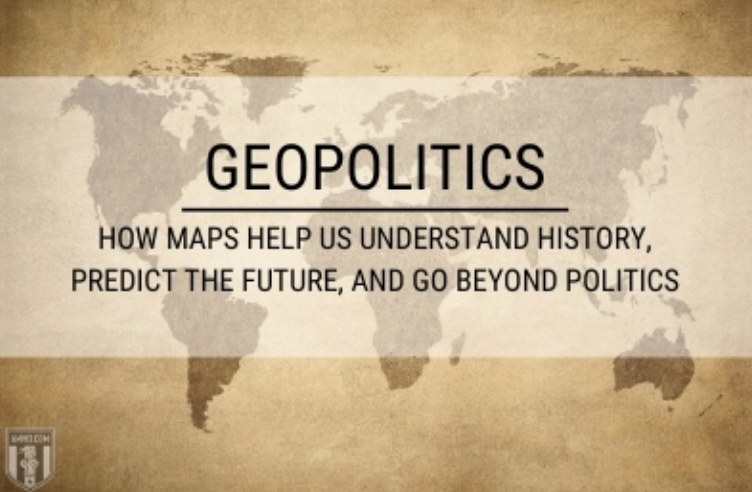“It is not often that nations learn from the past, even rarer that they draw the correct conclusions from it.” ~ Henry Kissinger
American students are notoriously bad at geography, and have been for some time. In 2002, for instance – the year after the 9/11 attacks – only 17% of American students could find Afghanistan on a map. In 2016, less than one third were able to score a minimal pass of 66% on the National Geographic Global Literacy Survey. In 2015, the United States Government Accountability Office reported that 75% of eighth grade students don’t even know what geography is.
Picture your old-school geography class. More likely than not, it was a boring subject requiring rote memorization of global factoids, U.S. state names, and their capitals. This does American students a disservice, because an appreciation for the hidden power of geography helps one make sense of seemingly random historical tidbits, more accurately predict the future, and see beyond political rhetoric to what actually matters among nation-states.
When contemplating geography’s usefulness in better understanding our world, consider the following:
- Why is it important to the state to get a handle on its subjects and their environments, i.e., through long-established practices like land registries and the creation of permanent last names? Or more recent examples such as the census bureau, the passport system, the DMV, birth and death certificates, or just registering to vote?
- Why is the state seemingly always the enemy of “people who move around,” i.e., nomads and pastoralists, hunter-gatherers, Gypsies, vagrants, homeless people, iterants, runaway slaves, and serfs? All have always been a thorn in the side of the state, and efforts to permanently settle these mobile peoples seem to rarely succeed.
The answers to these questions are straightforward when the classic imperatives of the state are known – and these are taxation, conscription, and the prevention of rebellion.
In order to satisfy these imperatives, the state has to know as much as possible about its inhabitants, and it wants them to be sedentary. You can’t tax what you can’t measure. You can’t draft someone to fight if you don’t know they exist. And you can’t stop a rebellion if you don’t know those who seek to overthrow your order.
As a result of these imperatives, accurate maps of the land and the people that occupy it are necessary for the survival of the state. And what’s in those maps is as important as what’s excluded from them.
Geography’s raison d’etre is straightforward: to write about, describe, or better understand patterns and processes on Earth. It’s not just maps and state capitals, nor is it simply the creation of maps (that’s cartography).
Thus, when the hidden power of geography is appreciated – especially as it relates to the state’s imperatives – conflicts between competing states as well as the relationship between the state and the individual begins to make more sense.
Early Geography: The Printing Press and “Imagined Communities”

To begin with a basic concept of geographic history, it’s important to consider the difference between a nation and a state. It is common today for the term “nation” and “country” to mean the same thing, but in geography, “country” actually means “state” and the term “nation” is defined by a shared identity among a large population within a state.
This shared identity is what Benedict Anderson referred to as “imagined communities.” These communities of the imagination had early relationships to the invention of the printing press, which allowed people (other than elites) to have easier access to both maps and literature. Such publications contributed to standardizing languages, which allowed a variety of cultures to understand not only each other, but also the maps that explained the world.
The printing press contributed to standardizing the histories of the past so that many different cultures began to remember (and forget) the same things. According to Anderson, communities became imagined because people of even the smallest nations will never know or interact with the majority of people in that country. Yet, the majority will have an understanding of their shared histories.
From the Western perspective, the early history of geography has its origins during the Middle Ages. European travelers would explore beyond the edge of known territory and map their observations of different places, races and cultures. A common similarity of these early written accounts was that different types of climate were thought to be a defining factor for how races and cultures were different from the European traveler.
These early accounts were written from the perspective that European travelers were normal, and all non-Europeans were then defined by their difference. This is to say that according to these written accounts, Europeans were the reference point for what was normal and right.
During this period, the climates of the world were classified by three types: frigid (very cold), temperate (just right), and torrid (very hot). The frigid climate was thought to be too cold for people while the torrid climate was too hot. This understanding of the climate is why, for example, Ethiopians were thought to have lived too close to the sun, and that their skin was burnt black as a result – an observation considered a scientific fact because the European traveler was able to see it with their own eyes and then write about it.
An important aspect to these early written accounts was that as new cultures, terrain and races were “discovered,” they were often described as monsters from inhospitable lands. These monsters were commonly written about and became a source of both myth and legend. Such legends told of monstrous beings at the edge of where the known and unknown territories meet.
As these early Europeans embarked on new expeditions, each exploring further than the last, the unknown territories became known, but the monsters were always pushed further to the edge of the updated maps. According to Joanne Sharp, this pattern was a result of two factors.
First, the Europeans had a need to define their territory with myths and legends of the unknown monster because this was a defining factor for European identity. This is to say that an identity is not only based on how people are similar, but also how people are thought of as different.
The second factor was that for the earliest explorers during this time period, first contact and interaction with new cultures did generate fear. Sharp noted:
“Practices of lip stretching and yoga could seem like distorted bodies to the first travelers; warriors’ use of colorful shields might look – from a distance – like faces on their chests; and non-European languages could sound very alien to travelers.”
It was through these early expeditions that the Middle Aged maps of the world had a large influence on how people understood that world, and their place in it.
Roots of Geopolitics: From the Monarchy to the State
The transition from the Middle Ages to the 17th century is not marked by a single event, but rather several events over long periods of time. One of the more discussed events was the transition from the monarchy to state sovereignty, a move that marks the early origin of geopolitics.
From 1618 to 1648, one of the most destructive wars in history was waged in Central Europe. At its end, the “Thirty Years’ War” marked the creation of state sovereignty with the “Peace of Westphalia” settlement in 1648. This peace settlement defined territories by state sovereignty rather than a territory, and everything in it, owned solely by the monarchy. Sovereignty is the cornerstone of statehood and is defined by four basic principles:
- Defined boundaries of state territory.
- A government structure with absolute authority over internal and external affairs.
- Recognition by other states.
- A permanent population in that territory.
An important aspect to state sovereignty was that the population of a territory was no longer the property of the monarchy. A state relies on its territory as the source for political organization, but this became problematic because people who lived in those territories also had a new found freedom. They were no longer serfs, or considered property owned by the king, but now viewed as citizens of the sovereign state.
Similar to the previous example about monster myths being a political tool toward defining a European identity during the Middle Ages, maps and supporting literature played an essential role in not only marking a state’s territory, but also the imagined community of people inside and outside of that territory.
Prior to the rise of state sovereignty, loyalty to the monarchy could be an issue, and more so for the kings’ armies. It was not uncommon for these early armies to be made up of thieves and vagabonds as well as contracted mercenaries. These types of soldiers had little to no loyalty to the king, which was problematic for several reasons, one of which was because they were armed. Following the 1648 peace settlement, loyalty became tied to nationalism and the country.
This was an important development because, as mentioned, defining an identity results from shared similarities as well as differences. The expansion of territory through war could be more easily acceptable to the soldier if the enemy was different. However, when the enemy looked more like a friend, as can be found in any historical example of dueling Christian armies, the power of the state together with the nation changed the notion of territorial expansion from the “sport of kings” to a clash between nations.
Ready to learn more about Social Darwinism, Environmental Determinism, and the Hidden Power of Maps? Click here to go to the original article.


Join the conversation!